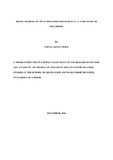| dc.description.abstract | This study sought to analyse print media coverage of pneumonia, as a reflection of how the
Kenyan press frame infectious diseases. Pneumonia is the second leading killer disease in Kenya,
claiming about 18 thousand lives each year. This ailment and other infectious diseases are
largely to blame for Kenya's high child mortality, thus compromising the country's ability to
attain the millennium development goals. By use of content analysis and textual analysis, the
study scrutinised pneumonia stories written in four newspapers (Daily Nation, Standard, Star and
East African) over a four year period, from January 2010 to December 2013. The study found
that though useful, the frames used to cover pneumonia in print media - mainly Action and
Consequence - are inadequate in passing across key pneumonia prevention and control messages
to the public. It also discovered that pneumonia is not a priority for the country's print media,
despite its severity. The study recommends an introduction of newer effective frames and
strategies aimed at increasing the quality and prominence in the coverage of pneumonia and
other infectious diseases in Kenya | en_US |

